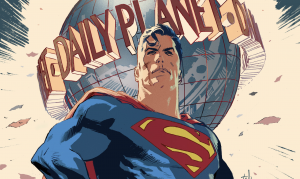
2010’s Alan Wake ends on a cliffhanger. After diving deep into Cauldron Lake to save his wife, Alice, from the Dark Presence that has consumed the town of Bright Falls, Washington, writer Alan Wake realizes something incredible. The power of a realm known as the Dark Place allows him to drastically alter his own reality using only his written words. So great is his ability to do so that he is even able to rescue both his wife and the town of Bright Falls simply by working away at his typewriter.
However, even Wake’s newfound powers have limitations. Despite his best efforts, Wake doesn’t seem to be able to free himself from the Dark Place. Instead, he elects to remain at the bottom of Cauldron Lake where he works on a seemingly neverending story designed to keep the forces of darkness at bay. Right before the credits roll, Alan Wake shares this ominous realization that seemingly doubles as the thesis statement for his infinite assignment:
“It’s not a lake, it’s an ocean.”
For quite some time, that was the last substantial thing we heard from Alan Wake. Though the character returned in a brief 2012 DLC expansion and a few sequences in developer Remedy Entertainment’s 2019 title, Control, neither resolved nor significantly advanced the plot of the original game. Fans of that game have long hoped that they would one day be able to pick up where that cliffhanger ending left off.
While Alan Wake 2 will continue that story, it will not pick up where that ending left off. At least not exactly. Instead, it takes us 13 years into the future to a fictionalized version of 2023. So where has Alan Wake been that whole time?
“He’s been stuck there for 13 years now, living in a nightmare,” explains Remedy Entertainment Creative Director and Alan Wake 2 co-director Sam Lake in an interview with Den of Geek. “He’s trying to write a perfect story that will allow him to escape and he’s failing again and again.”
Lake is of course referring to the situation that writer Alan Wake found himself in at the end of the last game. In many ways, though, he is also describing the situation that has impacted the Alan Wake franchise during that same stretch of time. More importantly, you kind of get the sense that Lake is referring to himself when he discusses the unique horror of trying to craft that perfect story that will not only allow a creator to escape 13 years of uncertainty but justify the time that went into all the work along the way.
It’s An Ocean
Alan Wake 2 has often felt like a kind of cursed project over the last 13 years. Though Lake and the Remedy team were eager to work on the sequel right away, publisher Microsoft was reportedly not interested in that project at that time. That initial rejection kicked off over a decade of disappointing delays that can be attributed to a variety of factors. The desire was there, but the opportunities were not.
“Certainly, there was a lot of frustration,” Lake says regarding Remedy’s numerous attempts to work on Alan Wake 2. “We went around trying to make it happen and pitching it to publishers…and it just wasn’t happening.”
During all that time, some Alan Wake fans gradually accepted that a sequel was never going to happen. It seemed destined to join the ranks of all the other great gaming sequels we’ll probably never get to see. Behind the scenes, though, there was always hope.
“We would not really think about Alan Wake 2 for a while, but we always came back to it and say, ‘Let’s try again,’” Lake says. “There were times when I was like, ‘Let’s see if we ever make it happen,’ but it was never on the level of ‘Let’s not even try.’”
Fan desires and unresolved cliffhangers aside, why was it so important for Lake to return to Alan Wake?
“I’m really proud of all of the games we have made, but, in some ways, Alan Wake always felt most special, personal, and dear to me,” Lake says. “Partly because of the subject matter and him being a writer, for sure, and partly because we were just coming out of Max Payne [when developing Alan Wake]. That having been our first successful game, we were like, ‘Okay, now we have the experience and now we can come up with a concept we’re really excited about’…It felt personal.”
Still, 13 years is a long time. A lot can change over that time, including projects as passionate as Alan Wake 2. So how much does the 2023 version of Alan Wake 2 share with Sam Lake’s initial vision for that sequel?
“Very little,” Lake reveals. “On a concept level, there has always been a draft of what the story is. But that has changed quite a bit. It certainly wasn’t the story, even if certain elements from that are still present in this story…Beyond that, what the actual story and setup is, what the structure is, what, now even, the genre of the game is…a lot changed along the way.”
Alan Wake: The Return
It’s those changes that got me thinking of Twin Peaks. While the Pacific Northwest-set Alan Wake has always worn its Twin Peaks influences on its sleeve, Alan Wake 2 feels closer to 2017’s Twin Peaks: The Return. Both aspire to revive beloved franchises after a prolonged period of time in a way that satisfies those who waited all those years. Yet, both also want to reflect the ways their creators (and the world) have grown and changed during that same period of time. It’s a delicate, almost impossible balance that Lake is very familiar with.
“That was something we acknowledged going into this,” Lake says regarding the challenges of crafting Alan Wake 2 for new and returning players. “We really wanted to create a self-contained experience for someone who has never played any Remedy games to go in and be excited about going on this ride.”
The desire to speak directly to new players partially resulted in one of Alan Wake 2’s biggest changes: the addition of Saga Anderson, an FBI investigator who serves as Alan Wake 2’s second playable protagonist. More than a largely necessary narrative addition (Alan is still stuck in a lake, after all) Saga doubles as a kind of player surrogate character for those just joining the adventure.
“Saga Anderson is a new hero character and kind of a modern hero character for us,” Lake explains. “We start the game playing as her as she is an FBI investigator coming to this small town setting…she is also the point of view character for new players who are coming into this world and into this experience. She is learning about it, and she’s adjusting in order to survive. The player is also learning about these things and adjusting to survive.”
The word “survive” feels especially important in any discussion about Alan Wake 2‘s various changes given the sequel’s overall pivot to the survival horror genre. Though the original Alan Wake was certainly a horror game, it was the kind of “action horror” experience that was slightly more prevalent in its time. Alan Wake 2 sometimes feels closer to a survival horror title developed in the post-Resident Evil 2 Remake era. There’s even a greater emphasis on puzzles, which is wonderfully highlighted by “case board” sequences that require you to piece together clues in order to unlock new interactions and new paths forward.
And yes, that change in genre means greater scares and more of them. However, you probably shouldn’t expect Alan Wake 2 to be one of those overwhelmingly horrifying modern gaming experiences. Mind you, it’s plenty scary when it wants to be, but the team’s interest in exploring the depths of the horror genre is rooted in more than a desire to simply scare you.
A Flashlight in the Darkness
There are some works of horror that are so effective you never want to experience them more than once (if you make it through them at all). Though we often praise such works, their effectiveness can be a double-edged sword. How do you keep someone entertained when that entertainment is based on terrifying them?
“It’s a fine balance,” says Alan Wake 2 co-director, Kyle Rowley. “I’ve played some horror games where I’m like, ‘Oh, this is almost too scary.’ It’s so scary I don’t want to play it anymore. We had to find a nice balance between having those scary moments and then some levity to release it so you can go on and do something else.”
Though you will find those moments of levity in Alan Wake’s humorous interactions and numerous clever world details, you shouldn’t expect to experience many of them in Alan Wake 2’s combat sequences. There may be fewer action sequences in Alan Wake 2 than in Alan Wake, but their increased intensity makes up for the discrepancy.
“We knew there were going to be fewer enemies and that we wanted them to be on screen for longer and have more of a presence,” Rowley says. “So we asked, ‘How can we make that gameplay loop slightly more refined so that it’s not just wait for a long time and then fight?’”
Along with the aforementioned puzzles, investigation mechanics, and interaction opportunities, part of that solution involves the return of Alan Wake‘s iconic flashlight. Much like the original game, most of Alan Wake 2’s fights require you to utilize a flashlight in order to wear enemies down before you can defeat them. Though that mechanic defined the original Alan Wake from a gameplay and thematic perspective, it also turned off some who simply wanted to treat Alan Wake as more of an action game than the flashlight would ever allow for.
However, that flashlight not only feels like a better fit for Alan Wake 2’s more methodical survival horror fights but it serves as a reminder that, for all its changes, Alan Wake 2 is still very much an Alan Wake game.
“I’m sure some people were like, ‘Do we need this?’” says Rowley regarding the returning flashlight combat mechanic. “But when we were thinking back to what made Alan Wake iconic and what differentiated it from the gameplay side of things, the idea of using light and darkness was definitely something unique to Alan Wake…the big difference was that we wanted to switch it from ‘Fight With Light’ to ‘Survive With Light.’”
There it is again. The word “survival.” Appreciating Alan Wake 2‘s changes and what they represent seems to revolve around understanding the complete significance of that word. Yet, one of the biggest reasons this sequel made the swap to the survival horror genre has nothing to do with combat, the modern market, or even scares. It was actually always about the storytelling.
In and Out of Control
“That’s part of the reason why we ended up switching the genre of the game,” Lake explains. “For me, interactive storytelling and the ambition to push that as far as we possibly could meant we needed mechanics and gameplay mechanics that are about story and about following the story and piecing together that story.”
The desire to emphasize Alan Wake 2‘s interactive storytelling elements certainly helps explain the sequel’s more methodical combat, enhanced atmosphere, and even its puzzles, but it also crucially impacts one of Alan Wake 2’s biggest changes: the game’s slightly more open-ended levels and the increased freedom of exploration they allow for.
For those used to the original Alan Wake’s more linear levels, those larger areas will undoubtedly feel slightly jarring. In some ways though, they’re really just an extension of the level design seen in 2019’s Control.
For Alan Wake fans who spent years doubting a sequel would ever happen, the impact of Control can’t be overstated. It not only set up the Remedy Connected Universe that Alan Wake 2 will be a big part of, but it also served as a kind of testing ground for Alan Wake 2’s new level structure.
“Control was a big transition for that,” Lake says regarding Alan Wake 2‘s level design. “That was, very purposefully, part of the design and it took some figuring out in terms of how to tell a story as you trek through the world. We relied more on that world for the storytelling in Control than ever before…We could not have made Alan Wake 2 without first making Control and learning about that different kind of structure.”
Design and narrative influences aside, Control gave the Alan Wake 2 team the confidence they needed to trust their vision.
“We just wanted to make something that really excites us,” Lake says. “Control was something that gave us certainty because we got to say ‘Let’s go do a unique, even weird, experience that we feel excited about.’ Then it did find its audience and, and it was a big success for us. In some ways, that was assurance that we can go do our own thing that we feel good about and that it will find an audience.”
Finding an audience is perhaps the toughest part of any conversation about Alan Wake 2. The original Alan Wake was more than a cult classic, but it didn’t necessarily achieve the kind of sales figures that we associate with the biggest modern Triple-A games. Perhaps more importantly, Alan Wake 2 is being released at the end of one of the busiest years in gaming history. 2023 has seen not just an unusual influx of high-profile titles but an unusual influx of incredibly well-made high-profile titles. October alone has already gifted gamers with game-of-the-year contender experiences like Assassin’s Creed Mirage, Marvel’s Spider-Man 2, and Super Mario Bros. Wonder.
Lake is very aware of what he rightly refers to as a “crazy busy year” in gaming. He is also aware of the various challenges Alan Wake 2 faces in such an environment. Yet, there are other factors at play at the moment that he believes could help the game find an even larger audience of adamant fans this time around.
The Poetry of Fear
“Certainly, horror is now embraced more by the mainstream than it was even in 2010,” Lake says regarding how Alan Wake 2 may fare in 2023. “Great horror films are coming out, horror novels are being read more widely than ever before, and also, I feel that when we look at streaming shows, audiences are more savvy with layered and complex storytelling than ever before.”
Of all the fascinating things there are to say about Alan Wake 2 and its incredible road to release, it’s that idea that now (and not five or 10 years ago) may actually be the best time for the game to finally see the light of day. Though it seems like a slight exaggeration to say that Lake wouldn’t have worked on and released this game sooner if circumstances had allowed for him to do so, you do get the sense that the version of Alan Wake 2 we will soon get to play will be greater than any other version of the game that could have existed up until this point.
“It always led to us working on a different game, and that was exciting,” Lake says regarding Alan Wake 2’s long road to release. “For me, it feels for the better. Even though it was really, really frustrating along the way, I’m so happy that this is how it went.”
Most creators are not Alan Wake. They can’t always reshape the world at will using their words, suggestions, and best intentions. If they could, then perhaps the story of Alan Wake’s release and Alan Wake 2’s development would have gone very differently. Then again, even Alan Wake couldn’t free himself from the bottom of that lake over the last 13 years. There was still too much work that needed to be done.
Yet, there can be so much beauty in that work. A creator may not get to determine how their work impacts or enters the world, but they do have a say in the quality of the work they put into the world and how it represents the passion, purpose, and, yes, even the time that went into it.
Well, every piece of Alan Wake 2 I have seen, heard, and played so far suggests it is very much that rare kind of passion project that feels born from the same resolve that allows one to endure 13 years at the bottom of a lake — or 13 years in the often equally dark and uncertain world of the video game industry — just to have the opportunity to share that perfect story.
Alan Wake 2 is scheduled to be released on October 27, 2023, for PlayStation 5, Xbox Series X/S, and PC.
The post Alan Wake 2 Allowed Creator Sam Lake to Complete a 13-Year Odyssey appeared first on Den of Geek.






